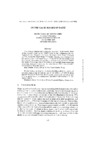Identificador persistente para citar o vincular este elemento:
https://accedacris.ulpgc.es/jspui/handle/10553/294
| Campo DC | Valor | idioma |
|---|---|---|
| dc.contributor.author | Pacheco Castelao, José Miguel | en_US |
| dc.contributor.author | Fernández de la Nuez, Isabel | en_US |
| dc.date.accessioned | 2009-10-08T02:31:00Z | |
| dc.date.accessioned | 2018-03-01T13:41:37Z | - |
| dc.date.available | null | |
| dc.date.available | 2018-03-01T13:41:37Z | - |
| dc.date.issued | 2003 | en_US |
| dc.identifier.issn | 1130-4723 | en_US |
| dc.identifier.other | 1787 | - |
| dc.identifier.uri | https://accedacris.ulpgc.es/handle/10553/294 | - |
| dc.description.abstract | The authors present from a heuristic viewpoint an elementary study of the unusual magic square (GMS) found in the outstanding Gaudí's Sagrada Familia Temple in Barcelona. Its magic sum is 33 and it features on rows, columnns, diagonals and 2/2 broken diagonals, and on many 2 x 2 subsquases, such as the central one or the one formed by the entries at the four corners. Elementary Group Theory is introduced as a natural tool in the study of the magic square in order to analyse how these magic-sum preserving structures wander on the torus (Z/4) x (Z/4), the geometric counterpart of the plane square. | en_US |
| dc.description.abstract | En este trabajo se presenta un estudio heurístico elemental acerca del cuadrado mágico que se halla en una de las fechadas del Templo de la Sagrada Familia de Barcelona. Se introducen nociones de teoría de grupos y de su acción sobre la contrapartida geométrica del cuadrado, el toro (Z/4) x (Z/4). | en_US |
| dc.language | eng | en_US |
| dc.relation.ispartof | Revista de la Academia Canaria de Ciencias | en_US |
| dc.source | Revista de la Academia Canaria de Ciencias [ISSN 1130-4723], v. 15 (1-2), p. 147-153 | en_US |
| dc.subject | 12 Matemáticas | en_US |
| dc.subject | 120706 Teoría de juegos | en_US |
| dc.subject.other | Group | en_US |
| dc.subject.other | Group action | en_US |
| dc.subject.other | Magic square | en_US |
| dc.subject.other | Torus | en_US |
| dc.subject.other | Acción de un Grupo | en_US |
| dc.subject.other | Cuadrado Mágico | en_US |
| dc.subject.other | Grupo | en_US |
| dc.subject.other | Toro | en_US |
| dc.title | On the magic square of Gaudí | en_US |
| dc.type | info:eu-repo/semantics/article | en_US |
| dc.type | Article | en_US |
| dc.contributor.contentdm | Departamento de Matemáticas | es |
| dc.contributor.contentdm | Modelos matemáticos en gestión ambiental | es |
| dc.identifier.absysnet | 302880 | - |
| dc.identifier.crisid | -;1122 | |
| dc.description.lastpage | 153 | en_US |
| dc.description.firstpage | 147 | en_US |
| dc.investigacion | Ciencias | en_US |
| dc.rights.accessrights | info:eu-repo/semantics/openAccess | es |
| dc.type2 | Artículo | en_US |
| dc.utils.revision | Sí | en_US |
| dc.identifier.supplement | -;1122 | - |
| dc.identifier.ulpgc | Sí | en_US |
| dc.contributor.buulpgc | BU-BAS | en_US |
| item.grantfulltext | open | - |
| item.fulltext | Con texto completo | - |
| crisitem.author.orcid | 0000-0003-4027-8608 | - |
| crisitem.author.fullName | Pacheco Castelao, José Miguel | - |
| crisitem.author.fullName | Fernández De La Nuez, Carmen Isabel | - |
| Colección: | Artículos | |
Visitas
84
actualizado el 12-oct-2024
Descargas
105
actualizado el 12-oct-2024
Google ScholarTM
Verifica
Comparte
Exporta metadatos
Los elementos en ULPGC accedaCRIS están protegidos por derechos de autor con todos los derechos reservados, a menos que se indique lo contrario.
